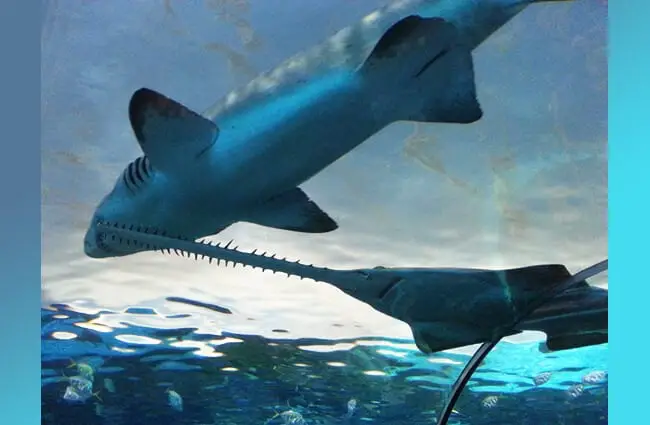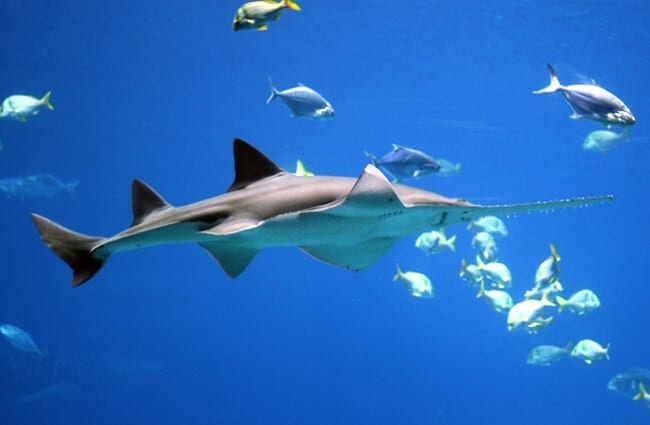The ocean holds many secrets, but few creatures are as captivating and peculiar as the sawfish. Often described as a living saw, these elasmobranchs, relatives of sharks and rays, possess a unique and elongated rostrum, or snout, lined with toothlike structures. This remarkable adaptation, combined with their dwindling numbers, makes sawfish a subject of both scientific fascination and urgent conservation concern. This comprehensive guide explores the world of sawfish, from their evolutionary history and unique biology to their vital role in marine ecosystems and the threats they face.

An Ancient Lineage: Sawfish Evolution
Sawfish are not new to the scene. Their evolutionary history stretches back over 100 million years, to the Early Cretaceous period. Fossil records demonstrate that ancient sawfish differed significantly from their modern counterparts, with some possessing multiple rostra or very different rostrum tooth arrangements. The evolution of the rostrum is believed to have been driven by the need to detect and capture prey in murky waters. Over millions of years, natural selection favored individuals with longer, more sensitive rostra, eventually leading to the iconic saw we know today. Currently, there are seven recognized species of sawfish found in tropical and subtropical regions worldwide. These include the Smalltooth Sawfish, Largetooth Sawfish, Green Sawfish, Narrowsnout Sawfish, Dwarf Sawfish, Freshwater Sawfish, and Japanese Sawfish, each adapted to specific habitats and prey.
Decoding the Saw: Anatomy and Function
The most defining characteristic of sawfish is, undoubtedly, their rostrum. This flattened, elongated snout is not bone, but rather a specialized extension of the cartilage skeleton, covered in electroreceptors similar to those found in sharks. These receptors allow sawfish to detect the weak electrical fields produced by other organisms, even those buried in the sediment. The teeth along the rostrum are actually dermal denticles, modified placoid scales like those covering shark skin. They aren’t used for chewing, but serve as sensors and are used to pin or injure prey. Beyond the rostrum, sawfish share typical elasmobranch characteristics. They possess a cartilaginous skeleton, lack swim bladders, and reproduce via internal fertilization.

What Do Sawfish Eat? A Peek into Their Diet
Sawfish are opportunistic predators, with their diet varying based on species, size, and habitat. Smaller sawfish typically feed on small fish, crustaceans, and worms. Larger species target a wider range of prey, including larger fish, squid, and even other sharks. They use their rostrum in several ways to capture food. They can slash at schools of fish, stunning or injuring them, then consume the disabled prey. They also stir up the seabed, uncovering buried invertebrates. The rostrum is also used to taste the seafloor, locating prey via electroreception.
Habitat and Distribution: Where Do Sawfish Live?
Sawfish inhabit a variety of marine and estuarine habitats, including shallow coastal waters, bays, lagoons, and river mouths. They are found in tropical and subtropical regions across the globe, with the highest concentrations in Australia, Florida, and parts of the Indo-Pacific. Some species, like the Freshwater Sawfish, are exclusively found in freshwater rivers and lakes. They prefer habitats with muddy or sandy bottoms, providing ample foraging opportunities. Estuarine habitats are particularly important as nursery grounds for young sawfish, offering protection from larger predators and an abundance of food.

Life Cycle: Mating, Reproduction, and Growth
Sawfish have a unique reproductive strategy. They exhibit a form of internal fertilization, with males possessing claspers used to transfer sperm to females. Unlike many sharks and rays, sawfish are ovoviviparous, meaning that eggs develop inside the mother’s body, and pups are born live. Gestation periods can be quite long, lasting up to a year or more. Litter sizes are typically small, ranging from one to fifteen pups. Sawfish are slow growing and late maturing, meaning they don’t reach sexual maturity until several years after birth. This, coupled with their low reproductive rates, makes them particularly vulnerable to overfishing and habitat loss.
Sawfish in the Ecosystem: A Vital Role
As apex predators, sawfish play a crucial role in maintaining the health and balance of marine ecosystems. By controlling populations of smaller fish and invertebrates, they help prevent any single species from becoming dominant. Their foraging behavior also stirs up the seabed, aerating the sediment and promoting nutrient cycling. Additionally, sawfish serve as indicators of environmental health. Their sensitivity to habitat degradation and pollution means that declines in sawfish populations can signal broader problems within the ecosystem.

Human Interactions: Threats and Conservation
Sadly, all seven species of sawfish are now listed as endangered or critically endangered. The primary threats to sawfish populations are habitat loss, bycatch in fisheries, and the demand for their rostrum as a novelty item or in traditional medicine. Sawfish are often unintentionally caught in gillnets, trawls, and longlines, leading to injury or death. Their slow reproductive rates make it difficult for populations to recover from these losses. Conservation efforts are underway in many parts of the world, including habitat protection, fishing gear modifications, and public awareness campaigns. International trade in sawfish parts is also regulated under CITES (Convention on International Trade in Endangered Species).
Encountering a Sawfish: What To Do
If you are fortunate enough to encounter a sawfish in the wild, it is crucial to observe it from a distance and avoid any interaction. Do not attempt to approach, touch, or feed the animal. Report your sighting to local marine authorities or conservation organizations, as this information can help track populations and monitor their health. If you accidentally hook a sawfish, carefully cut the line as close to the hook as possible, allowing the animal to swim away. Never attempt to remove the hook yourself, as this could cause further injury.

Caring for Sawfish in Captivity
Maintaining sawfish in captivity presents significant challenges. Large tanks with complex environments are essential to provide adequate space for swimming and foraging. Water quality must be meticulously monitored and maintained. A varied diet of fish, crustaceans, and squid is crucial to ensure proper nutrition. Enrichment activities, such as introducing novel objects or creating currents, can help stimulate natural behaviors. Care must be taken to prevent injuries to the rostrum, as it is easily damaged. Regular veterinary checkups are essential to monitor the animal’s health.
A Future for Sawfish
The fate of sawfish hangs in the balance. While the challenges are significant, there is still hope for their recovery. Through continued conservation efforts, sustainable fisheries management, and increased public awareness, we can ensure that these remarkable creatures continue to grace our oceans for generations to come. The sawfish, a living relic of a bygone era, deserves our protection.

![Red Angus Closeup of a beautiful Red Angus cowPhoto by: U.S. Department of Agriculture [pubic domain]https://creativecommons.org/licenses/by/2.0/](https://animals.net/wp-content/uploads/2020/03/Red-Angus-4-238x178.jpg)




![Red Angus Closeup of a beautiful Red Angus cowPhoto by: U.S. Department of Agriculture [pubic domain]https://creativecommons.org/licenses/by/2.0/](https://animals.net/wp-content/uploads/2020/03/Red-Angus-4-100x75.jpg)

